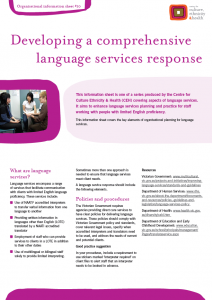How Can We Help?
 This resource is also available in pdf.
This resource is also available in pdf.
Download Developing a comprehensive language services response
Access other tip sheets in this series
The key elements of organisational planning for language services.
What are language services?
Language services encompass a range of services that facilitate communication with clients with limited English language proficiency. These services include:
- Use of NAATI(1) accredited interpreters to transfer verbal information from one language to another
- Providing written information in languages other than English (LOTE) translated by a NAATI accredited translator
- Employment of staff who can provide services to clients in a LOTE in addition to their other duties
- Use of multilingual or bilingual staff solely to provide limited interpreting.
Sometimes more than one approach is needed to ensure that language services meet client needs. A language service response should include the following elements.
Policies and procedures
The Victorian Government requires agencies providing direct care services to have clear policies for delivering language services. These policies should comply with Victorian Government policy and standards, cover relevant legal issues, specify when accredited interpreters and translators need to be used, and address the needs of current and potential clients.
Good practice suggestion
In your procedures, include a requirement to use stickers marked ‘interpreter required’ on client files to alert staff that an interpreter needs to be booked in advance.
Dedicated resources
Make sure that you set a budget and allocate funding to language services in the planning phase of a service or project. The allocation of funding should reflect the anticipated need for these services and be monitored to respond to changing circumstances or demographics.
Good practice suggestion
Allocate responsibility to a staff member for coordinating and monitoring language services, including a budget allocation.
Staff training
Staff require a level of knowledge and skill to use language services effectively. Training can be provided in-house or by an external trainer and should be offered at employee induction and on a regular basis to ensure skill maintenance.
Good practice suggestion
Provide relevant training tailored to the diverse needs of staff on an annual basis.
Quality improvements
It is important to monitor and evaluate the quality, use and effectiveness of language services. Report the results across your organisation to provide feedback to staff. Data can also be used to monitor processes and measure improvements.
Good practice suggestion
A central language services booking system will enable your organisation to monitor use, trends and unmet needs, and ensure that resources are used efficiently.
Promoting language services
Promote the availability of interpreters as widely as you can. Place signage, such as the National Interpreter Symbol, posters and brochures (including interpreter cards) in foyers and reception areas. You should also take an active approach by distributing interpreter cards and informing clients of the availability of interpreting services rather than waiting for them to ask.
Good practice suggestion
Promote the availability of interpreters during information sessions to community groups.
Resources
The Centre for Culture Ethnicity & Health (CEH) offers training in using language services, as do most interpreting and translation service providers.
Resources
The Victorian Government has information kits and resources promoting the availability of professional interpreters. These include posters, stickers and interpreter cards. Most interpreting agencies provide posters that promote the availability of interpreters.
Reference:
- The National Accreditation Authority for Translators and Interpreters (NAATI) is the national standards body for interpreting and translating in Australia.
Links to other tip sheets in the language services series
This information sheet is one of a series produced by the Centre for Culture Ethnicity & Health (CEH) covering aspects of language services. Other tip sheets in this series include:
- Interpreters: an introduction (2014): Interpreting is the oral translation of speech between two different spoken languages…
- Assessing the need for an interpreter (2014): Whenever possible, the need for an interpreter should be decided before an appointment…
- Booking and briefing an interpreter (2014): Getting the best interpreter starts at the booking stage.
- Communicating via an interpreter (2014): Here are some tips to make the interpreted conversation more effective and efficient…
- Debriefing with an interpreter (2014): The debriefing a mutual learning process and contributes to a higher quality of communication…
- Translation: an introduction (2014): Translation means converting written information from one language into another…
- Planning for translation (2014): Undertaking translation is a process and should be considered a project with a budget and timelines…
- Recruiting bilingual staff (2014): Victorian Government language services policy recognises bilingual staff as a valuable part of an agency’s language services response to people with limited English proficiency…
- Managing bilingual staff (2014): Bilingualism is the ability to communicate in two languages with equal, or near equal, fluency…
Resource Type: Tip/Fact Sheets

 This resource is also available in pdf.
This resource is also available in pdf.